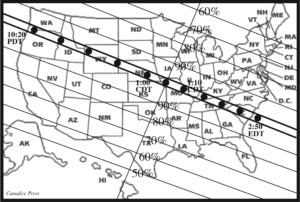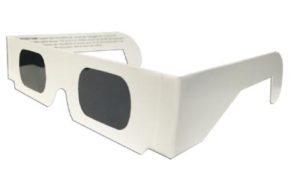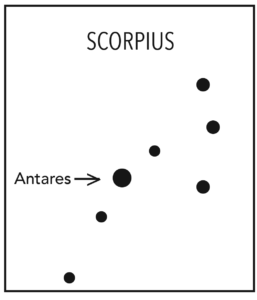The Sky in August 2017 – Eclipse
by Dee Sharples –
 Monday, August 21, is a special date to mark on your calendars. On that day the Great American Eclipse, a total solar eclipse, will occur in several states from Oregon to South Carolina as the Moon crosses in front of the Sun and blocks 100% of its light. In our area of New York State, we’ll witness a partial eclipse with only 70% of the Sun blocked by the Moon.
Monday, August 21, is a special date to mark on your calendars. On that day the Great American Eclipse, a total solar eclipse, will occur in several states from Oregon to South Carolina as the Moon crosses in front of the Sun and blocks 100% of its light. In our area of New York State, we’ll witness a partial eclipse with only 70% of the Sun blocked by the Moon.
The Moon orbits the Earth approximately every 28 days. When the Moon happens to lie directly between us and the Sun, it covers all or part of the Sun and we experience a solar eclipse.
How can the Moon which is so much smaller than the Sun completely block it during a total solar eclipse? While the Moon is about 400 times smaller than the Sun, it happens that the Sun is about 400 times farther from us. From our vantage point on Earth, they appear to be almost exactly the same size in the sky. The Moon on average is 239,000 miles from Earth and the Sun is approximately 93,000,000 miles away.
In Canadice, NY the eclipse will begin at 1:14 PM. The Moon, up until then, will be invisible in the daytime sky. As the eclipse begins, it will start to look like a bite is being taken out of the Sun and will slowly grow larger over approximately the next hour and a half. The peak of the eclipse, when 70% of the Sun will be blocked by the Moon, will be at 2:36 PM. As the Moon continues to slowly travel across the sky, more and more of the Sun will start to reappear. The eclipse will end at 3:53 PM when the Moon no longer blocks any portion of the Sun.
No matter where you are in the Finger Lakes region, these times will vary by only a few minutes.
The Rochester Museum and Science Center will have a special Solar Eclipse Day on August 21. Check out their website for details. http://www.rmsc.org/strasenburghplanetarium/shows/item/454-solar-eclipse-day
 Remember that it’s critical to protect your eyes during the entire length of the partial eclipse which we will experience. Sunglasses will not protect your eyes from the intense damaging rays of the Sun. Inexpensive solar eclipse glasses with special lenses can be purchased on-line or at the Rochester Museum and Science Center.
Remember that it’s critical to protect your eyes during the entire length of the partial eclipse which we will experience. Sunglasses will not protect your eyes from the intense damaging rays of the Sun. Inexpensive solar eclipse glasses with special lenses can be purchased on-line or at the Rochester Museum and Science Center.
In those states where people are lucky enough to be in the 70 mile wide path of the total solar eclipse, the peak of the eclipse will be short, but phenomenal, lasting only about two minutes. Day will turn into twilight and the brighter stars will begin to appear in the darkened sky. The temperature can drop 10 degrees as the heat from the Sun is blocked. Streamers of solar gas, or prominences, will be seen on the edges of the blocked Sun.
Although we won’t have this fantastic experience in our area because we will have only a partial eclipse, save your protective eclipse glasses and the date – April 8, 2024 – when a TOTAL solar eclipse will occur in the Rochester area!
 Around 10:00 PM on August nights, look toward the south near the horizon. You can easily spot the constellation Scorpius with its stars forming the outline of a scorpion. It’s one of the few constellations that resembles its name. Three stars about the same brightness and spaced equal distance apart make up the head of the scorpion. Antares, the brightest star in this constellation, is a red supergiant and lies slightly below and to the left of these three stars. Antares is the heart of the scorpion. Because this constellation is located so close to the horizon, you won’t be able to see much of the scorpion’s curving tail. It’s made up of a series of fainter stars which lay below and left of Antares.
Around 10:00 PM on August nights, look toward the south near the horizon. You can easily spot the constellation Scorpius with its stars forming the outline of a scorpion. It’s one of the few constellations that resembles its name. Three stars about the same brightness and spaced equal distance apart make up the head of the scorpion. Antares, the brightest star in this constellation, is a red supergiant and lies slightly below and to the left of these three stars. Antares is the heart of the scorpion. Because this constellation is located so close to the horizon, you won’t be able to see much of the scorpion’s curving tail. It’s made up of a series of fainter stars which lay below and left of Antares.
Antares has a distinctly reddish hue when viewed with the naked-eye. Its reddish color indicates it’s a cooler star, only 6,500 degrees F in comparison to our Sun which is about 11,000 degrees F. Antares is also an old star nearing the end of its life, at which time it will explode as a very bright supernova.
The planet Saturn can be found in the southern sky in August about 30 degrees (3 fist-widths) up from the horizon to the left of the constellation Scorpius. It looks like a fairly bright yellowish star. Saturn’s beautiful ring system can only be enjoyed through a telescope, so if you can, come to the Rochester Museum and Science Center planetarium on clear Saturday nights to see it through one of their telescopes.
Let’s hope for clear skies on warm August nights and especially on eclipse day. There’s so much to enjoy in the night, and day, sky.